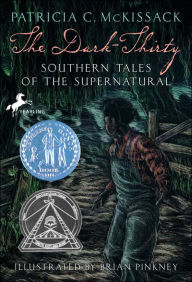When I first spotted Patricia C McKissak's The Dark-Thirty: Southern Tales of the Supernatural, with the Newberry Honor Award and the Coretta Scott King Award on the front cover, I had to bring it home with me. I thought it would contain thirty scary stories, but the 8 X 10 book contains ten. In the introduction to this book, McKissack explains, "When I was growing up in the South, we kids called the half hour just before nightfall the dark-thirty. We had exactly half an hour to get home before the monsters came out."
She says of this collection of tales, "This is a collection of original stories rooted in African American history and the oral storytelling tradition. They should be shared at that special time when it is neither day nor night and when shapes and shadows play tricks on the mind."
All of the stories in this collection are short, so you can read one or two a night and make them last for a week or more. Many of McKissack's 177 books educate readers and are based on history, and this collection is no different. Some of these tales are based on real stories, so this collection builds background knowledge, and shows the importance of kindness, courage, honesty, and integrity.
She concludes the book with a story from her own childhood, "The Chicken-Coop Monster." It is one of my favorites of the collection and made me remember being little and running as fast as I could from dark basements, garages, and tripping up the stairs to escape whatever horrible thing was behind me.
Her tale, "Justice," is just that, and has a fitting ending for a horrible man. This story shows the damage caused by Jim Crow laws, the KKK, and people not valuing the lives of those they considered different from themselves.
"The Woman in the Snow" will make you think twice about turning your back on someone who needs help. It is a classic ghost story that also educates about Rosa Parks, the Montgomery Bus Boycott, and the fight for equality.
Each story could be used in a Civil Rights history unit at Halloween time, and students could then write their own ghost stories based on their own life experiences or on one from history. While this book is interesting and enjoyable to read on its own, it has many applications in the classroom.
Do you have a favorite collection of scary short stories?

No comments:
Post a Comment